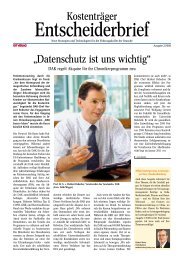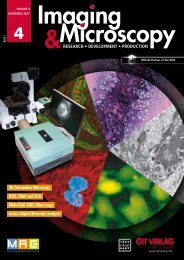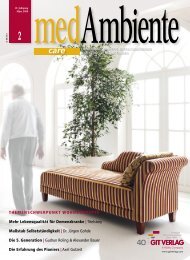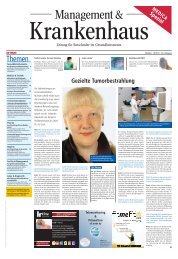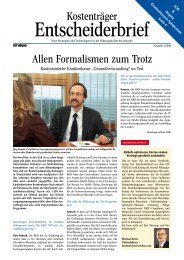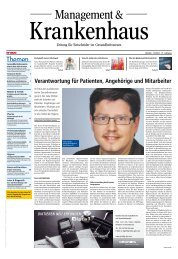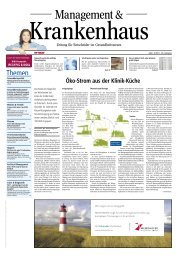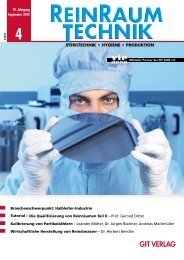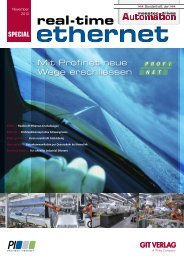Europe - GIT Verlag
Europe - GIT Verlag
Europe - GIT Verlag
Create successful ePaper yourself
Turn your PDF publications into a flip-book with our unique Google optimized e-Paper software.
Hospital Post <strong>Europe</strong> 04/08<br />
What a challenge for public<br />
health – this country sports,<br />
on 3.2 mn km 2 , 28 states and 7<br />
union territories. The number<br />
of official languages total 16;<br />
tax structures and regulatory<br />
frameworks are diverse. Out<br />
of the 1.1 bn population, 600<br />
mn are considered poor; and<br />
the democracy with its difficult<br />
past still struggles with<br />
the traditional caste system.<br />
The economy shows growth<br />
rates of 9 % – rather impressive<br />
to <strong>Europe</strong>ans – accompanied,<br />
however, by an inflation<br />
of 8.1 %.<br />
The spectrum of caregiving ranges from<br />
impressive high-quality, non-profit activities<br />
in, e.g., CVD and oncology, to medical<br />
tourism for elective therapy – e.g. hip replacement,<br />
for patients not only from the<br />
UK and the US. The major push for this<br />
sector comes from a growing middle class<br />
on the subcontinent – a quality and priceconscious<br />
target group of roughly 250 mn.<br />
– Your Hospital Post <strong>Europe</strong> editor brings<br />
to you this feature based on interviews<br />
with hospital and vendor representatives.<br />
After the independence of India, the<br />
healthcare infrastructure including district<br />
hospitals, community, and primary health<br />
centres was designed in line with WHO<br />
norms; however, availability of staff and<br />
medication was grossly inadequate. The<br />
situation improved when the corporate<br />
sector realized its social responsibilities,<br />
with corporate hospitals mushrooming.<br />
These state-of-the-art facilities, however<br />
– explains Dr. Saurabh Bhatia, a physician<br />
who today provides medical competence<br />
to TietoEnator’s software development<br />
work for the healthcare sector – “were<br />
beyond the reach of the average Indian,”<br />
at an annual per-capita income level of<br />
around US-$ 2,700 (China – 5,300, Germany<br />
– 34,400, US – 46,000; 2007 figures).<br />
The Situation Today<br />
“Traditional India came to rescue,” the expert<br />
continues: Spiritual gurus and trusts<br />
run by them started running charitable<br />
hospitals. The majority of them engaged<br />
in modern medicine, making it available<br />
to the needy. By 2005, the infant mortality<br />
rate, an indicator of the overall health status,<br />
was down to 56 (1960: 146; compare to<br />
China – 23, US – 6, Germany – 4 in 2005),<br />
with average lifetime up significantly.<br />
What is the current situation regarding<br />
healthcare in India – who has access to<br />
care and which groups do not, what are<br />
the differences between urban and rural<br />
areas, who is paying for care?<br />
HealthwareIndia is a major distributor<br />
that started out in 1989 for Dr. Mach (OR<br />
lights) and Blancomed (now Trumpf OR<br />
tables) and gradually specialized first in<br />
Urology (Dornier MedTech, Lisa Laser, B-K<br />
Medical, EMS and Gyrus-ACMI from UK/<br />
US) before adding Surgical (Gyrus-ACMI<br />
and B-K Medical). CEO Konakanchi Ram<br />
Narayan summarizes the present situation:<br />
“Despite the improving health status of the<br />
Indian population, healthcare infrastructure<br />
in the country has a long way to go to-<br />
wards achieving 100 % quality, technology,<br />
and superior healthcare delivery systems.”<br />
While the central government is limited<br />
to family welfare and disease control programs,<br />
the manager goes on to explain,<br />
the state governments are responsible for<br />
primary and secondary medical care, with<br />
a limited role in specialty care.<br />
Governmental share in the healthcare<br />
delivery market is roughly 20 %, while 80 %<br />
is provided through the private sector. The<br />
private healthcare providers consist of private<br />
practitioners, for-profit hospitals and<br />
nursing homes, and charitable hospitals;<br />
this market is now open for foreign investments.<br />
There is a huge difference in the quality<br />
of medical care available to the urban<br />
and rural population. Except for basic<br />
healthcare through the governmental primary<br />
health centres, the rural population<br />
have to go to the nearest city for advanced<br />
care. All governmental hospitals provide<br />
free care to poor patients. Government<br />
employees are covered by insurance (like<br />
CGHS, ESI, etc.) and have access to care either<br />
through governmental or private hospitals.<br />
All other salaried (= urban) patients<br />
either buy private insurance or pay out of<br />
their pockets. Healthcare spending currently<br />
amounts to over 6 % of the GDP, of<br />
which three quarters are “out-of-pocket”:<br />
Health Insurance<br />
Insurance is still in its infancy – in India,<br />
people are not used yet to paying without<br />
receiving, instantly, anything concrete<br />
in return, outlines Dr. Bhatia. Even after<br />
economic liberalization in the 1980’s, multinationals<br />
had to wait for the Indian government<br />
to open up this sector, which<br />
happened after 2000. Now, the market is attracting<br />
significant attention also from international<br />
actors who set up ventures such as<br />
Bajaj Allianz and Apollo DKV Insurance. The<br />
latter, a joint venture of a German payor and<br />
a privately held Indian hospital group, plans<br />
to invest up to 5 bn rupees in the next five<br />
years to increase its market share, according<br />
to Apollo Vice Chairperson Shobana<br />
Kamineni. The health insurer, according to<br />
Kamineni, aims at controlling at least 15 % of<br />
the total health insurance business in India<br />
which she estimates at currently US-$1 bn.<br />
The addressable market is middle class.<br />
Demand for medical and nursing colleges<br />
is also up.<br />
Who Takes Buying Decisions?<br />
Physicians are the decision makers regarding<br />
investment in medical technology – in<br />
particular regarding procurement for the<br />
attractive private caregiving segment which<br />
is not required to issue tenders. There are<br />
roughly 175 associations, and about 250<br />
medical congresses – a difficult environment<br />
for manufacturers and vendors who<br />
wish to present their products, as well as<br />
for organizers of general events for the<br />
hospital sector – as explains Mahesh Gidwani<br />
of Reed Exhibitions India. Only few<br />
multinationals have as yet gone into manufacturing<br />
activities in the country – this is<br />
a new trend in India, presumably sparked<br />
by the 15 – 16 % annual growth in medtech<br />
sales, Gidwani assumes.<br />
Focus on IndIA 5<br />
“Complex Situation, Incredibly Dynamic Outlook”<br />
Caregiving and Technology Penetration in India<br />
Dr. Girish Mehta, Manager,<br />
Wellspring Diagnostic Centre,<br />
Mumbai<br />
(Photos by Michael Waldbrenner<br />
and MR unless noted otherwise)<br />
Services and Technology<br />
in Diagnostics<br />
Piramal Diagnostics, part of a group of<br />
companies, operates about 85 diagnostic<br />
centres across the country. Services for<br />
caregivers include general pathology and<br />
basic blood-based diagnostics; some centres<br />
also carry out sonography, CT, etc.<br />
Asia’s first high-resolution PET-CT is also<br />
operated by Piramal, outlined Dr. Girish<br />
Mehta, who manages the highly reputed<br />
Wellspring Diagnostic Centre in Mumbai’s<br />
Lower Parel district. Wellspring’s many<br />
hospital contracts include, e.g., radiology<br />
outsourcing for the NABA-accredited<br />
Dr. Hiranandani Hospital.<br />
Whereas some centres sport full-time<br />
radiologists, others acquire reports from<br />
such centres in a private broadband teleradiology<br />
network. Difficult cases, too, are<br />
transmitted to specialists, e.g. in Mumbai.<br />
Reports are sent in pdf format; the PACS<br />
used is a proprietary solution, “developed<br />
at a fraction of the cost of a commercial<br />
system”. In total, roughly 4 mn patients<br />
are handled by the diagnostics division<br />
each year, with 150 highly qualified physicians<br />
on staff, summarized Dr. Mehta, with<br />
most devices, and reagents, imported from<br />
<strong>Europe</strong> – Siemens is the main supplier.<br />
While teleradiology services performed<br />
in the country for, e.g., caregivers in the<br />
US are still not an option due to physician<br />
approval issues, lab tests offer a promising<br />
business case: For <strong>Europe</strong>an caregivers,<br />
having lab tests carried out in India<br />
Vishal Bali, CEO, Wockhardt<br />
Group (Photo courtesy Wockhardt)<br />
is a huge opportunity for cost savings and<br />
higher throughput, underlined Dr. Mehta<br />
– “we already have, as an example, a US<br />
customer who sends us about 6,000 highend<br />
samples per year. We are accredited by<br />
the American College of Pathologists – the<br />
top-level international accreditation. Quality,<br />
therefore, is sound, and logistics from<br />
and to the UK, France, and Germany – to<br />
name examples – is fast and reliable.”<br />
“In general, the service level in India is<br />
a lot higher compared to <strong>Europe</strong> (and the<br />
US) – at a fraction of the cost,” is the physician’s<br />
conclusion – “my message to <strong>Europe</strong>ans<br />
and Americans is – we’ve got the best<br />
machines, best people, and best prices.”<br />
Research<br />
This, too, is an area where Indians collaborate<br />
with <strong>Europe</strong>ans, explains Dr. Mehta:<br />
earlier this year, Nicholas Piramal Life Sciences<br />
and Pierre Fabre Laboratories, in<br />
the presence of the French President, had<br />
signed an agreement on research in oncology.<br />
– And clinical studies can be done<br />
in this enormous patient market at a cost<br />
50 – 75 % below <strong>Europe</strong>an and US levels –<br />
adds Dr. S. K. Gupta, Dean of the Institute<br />
of Clinical Research (India).<br />
High-Level Therapy and<br />
Medical Tourism<br />
To Dr. Mehta, medical tourism is not a topic<br />
– as patients, Westerners come for therapy.<br />
Wockhardt’s CEO Vishal Bali benefits from<br />
this trend: In 2007, more than 3,000 international<br />
patients came for treatment to two<br />
Wockhardt sites, Mumbai and Bangalore.<br />
Around 7 – 10 % of Wockhardt’s revenue<br />
comes from medical tourism, a volume<br />
growing at 35 % annually; for the Apollo<br />
group, corresponding estimates are 12,000<br />
patients p.a., equalling 20 %. The Ministry<br />
of Tourism promotes such activities aggressively<br />
in its “Incredible India” campaign.<br />
Medical tourists largely come from the<br />
US, Canada, and <strong>Europe</strong>. Why is the US<br />
prevalent? “Healthcare is more privately<br />
driven there,” says Bali. “Those patients<br />
ask for choice, compared to social-driven<br />
caregiving in much of <strong>Europe</strong>.” JCAHO<br />
accreditation for the two Wockhardt sites<br />
is a key ingredient in this activity, according<br />
to Bali: US patients, or large corporations<br />
handling employee healthcare, take a close<br />
look at quality standards. “US insurers”,<br />
Vishal predicts, will soon offer low-premium<br />
products to their customers which include<br />
care in India; “here, care costs a third<br />
at the most, and can go down to as low as<br />
1/10th in comparison, for ophthalmology<br />
– plus the plane ride”. Out of <strong>Europe</strong>,<br />
patients from the UK are prevalent; they<br />
have a long tradition of being treated by<br />
Indian physicians, and long wait times are<br />
placing increasing stress on the NHS, with<br />
demographics giving an extra shove.<br />
To Wockhardt, medical tourism focuses<br />
mostly on elective surgery – much in<br />
orthopaedics, such as knee/hip/joint interventions,<br />
as well as spine surgery and cardiac<br />
procedures. The hospital group was<br />
recently awarded a prize for its website<br />
which largely facilitates the gathering of information<br />
to potential patients abroad.<br />
With no international airport until<br />
recently, Pune is no location for medical<br />
tourism. The Jehangir Hospital here was<br />
established in 1946. Today, the general<br />
hospital with 325 beds and a luxury suite<br />
is associated with the private Apollo group,<br />
and handles close to the entire medical<br />
spectrum. The caregiver sports, besides<br />
medical staff with top qualifications, a<br />
64-slice CT and more very modern technology.<br />
The primary reason why many<br />
Indian hospitals would not meet JCAHO<br />
criteria, according to a leading physician, is<br />
restricted space. Increasing awareness of,<br />
and pressure from, patients paying from<br />
their own pockets has led to significant improvements,<br />
the physician continued; e.g.,<br />
“No compromises on quality, and world class equipment” are key at Pune’s Fabiani & Budhrani Heart<br />
Institute (from left): cardiologist Dr. Ritu Dhawan-Bhatia, the reporter, and healthcare expert Dr. Saurabh<br />
Bhatia (TietoEnator)





